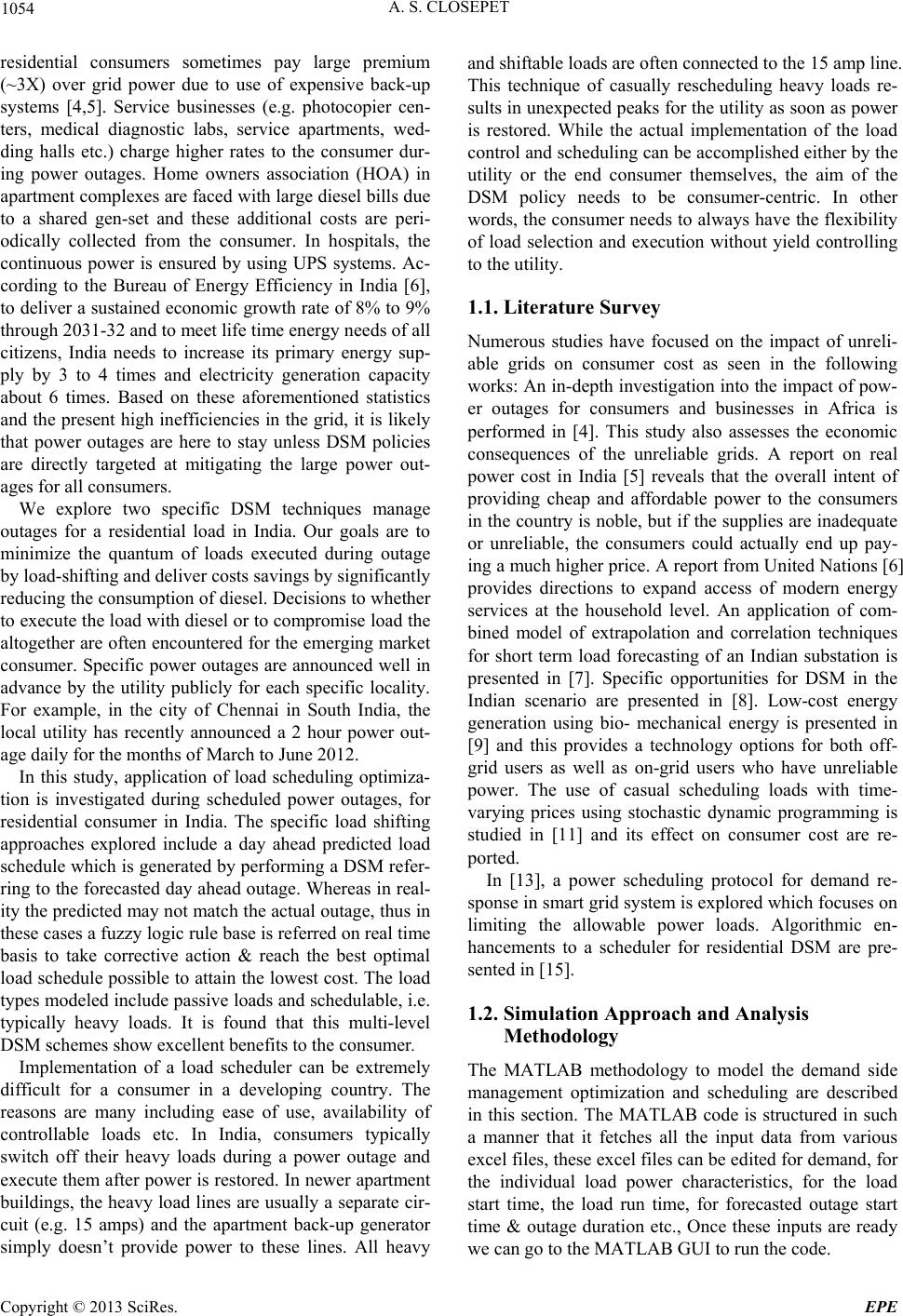
A. S. CLOSEPET
1054
residential consumers sometimes pay large premium
(~3X) over grid power due to use of expensive back-up
systems [4,5]. Service businesses (e.g. photocopier cen-
ters, medical diagnostic labs, service apartments, wed-
ding halls etc.) charge higher rates to the consumer dur-
ing power outages. Home owners association (HOA) in
apartment complexes are faced with large diesel bills due
to a shared gen-set and these additional costs are peri-
odically collected from the consumer. In hospitals, the
continuous power is ensured by using UPS systems. Ac-
cording to the Bureau of Energy Efficiency in India [6],
to deliver a sustained economic growth rate of 8% to 9%
through 2031-32 and to meet life time energy needs of all
citizens, India needs to increase its primary energy sup-
ply by 3 to 4 times and electricity generation capacity
about 6 times. Based on these aforementioned statistics
and the present high inefficiencies in the grid, it is likely
that power outages are here to stay unless DSM policies
are directly targeted at mitigating the large power out-
ages for all consumers.
We explore two specific DSM techniques manage
outages for a residential load in India. Our goals are to
minimize the quantum of loads executed during outage
by load-shifting and deliver costs savings by significantly
reducing the consumption of diesel. Decisions to whether
to execute the load with diesel or to compromise load the
altogether are often encountered for the emerging market
consumer. Specific power outages are announced well in
advance by the utility publicly for each specific locality.
For example, in the city of Chennai in South India, the
local utility has recently announced a 2 hour power out-
age daily for the months of March to June 2012.
In this study, application of load scheduling optimiza-
tion is investigated during scheduled power outages, for
residential consumer in India. The specific load shifting
approaches explored include a day ahead predicted load
schedule which is generated by performing a DSM refer-
ring to the forecasted day ahead outage. Whereas in real-
ity the predicted may not match the actual outage, thus in
these cases a fuzzy logic rule base is referred on real time
basis to take corrective action & reach the best optimal
load schedule possible to attain the lowest cost. The load
types modeled include passive loads and schedulable, i.e.
typically heavy loads. It is found that this multi-level
DSM schemes show excellent benefits to the consumer.
Implementation of a load scheduler can be extremely
difficult for a consumer in a developing country. The
reasons are many including ease of use, availability of
controllable loads etc. In India, consumers typically
switch off their heavy loads during a power outage and
execute them after power is restored. In newer apartment
buildings, the heavy load lines are usually a separate cir-
cuit (e.g. 15 amps) and the apartment back-up generator
simply doesn’t provide power to these lines. All heavy
and shiftable loads are often connected to the 15 amp line.
This technique of casually rescheduling heavy loads re-
sults in unexpected peaks for the utility as soon as power
is restored. While the actual implementation of the load
control and scheduling can be accomplished either by the
utility or the end consumer themselves, the aim of the
DSM policy needs to be consumer-centric. In other
words, the consumer needs to always have the flexibility
of load selection and execution without yield controlling
to the utility.
1.1. Literature Survey
Numerous studies have focused on the impact of unreli-
able grids on consumer cost as seen in the following
works: An in-depth investigation into the impact of pow-
er outages for consumers and businesses in Africa is
performed in [4]. This study also assesses the economic
consequences of the unreliable grids. A report on real
power cost in India [5] reveals that the overall intent of
providing cheap and affordable power to the consumers
in the country is noble, but if the supplies are inadequate
or unreliable, the consumers could actually end up pay-
ing a much higher price. A report from United Nations [6]
provides directions to expand access of modern energy
services at the household level. An application of com-
bined model of extrapolation and correlation techniques
for short term load forecasting of an Indian substation is
presented in [7]. Specific opportunities for DSM in the
Indian scenario are presented in [8]. Low-cost energy
generation using bio- mechanical energy is presented in
[9] and this provides a technology options for both off-
grid users as well as on-grid users who have unreliable
power. The use of casual scheduling loads with time-
varying prices using stochastic dynamic programming is
studied in [11] and its effect on consumer cost are re-
ported.
In [13], a power scheduling protocol for demand re-
sponse in smart grid system is explored which focuses on
limiting the allowable power loads. Algorithmic en-
hancements to a scheduler for residential DSM are pre-
sented in [15].
1.2. Simulation Approach and Analysis
Methodology
The MATLAB methodology to model the demand side
management optimization and scheduling are described
in this section. The MATLAB code is structured in such
a manner that it fetches all the input data from various
excel files, these excel files can be edited for demand, for
the individual load power characteristics, for the load
start time, the load run time, for forecasted outage start
time & outage duration etc., Once these inputs are ready
we can go to the MATLAB GUI to run the code.
Copyright © 2013 SciRes. EPE